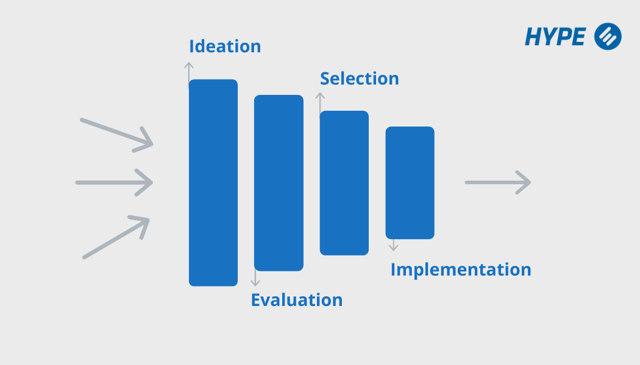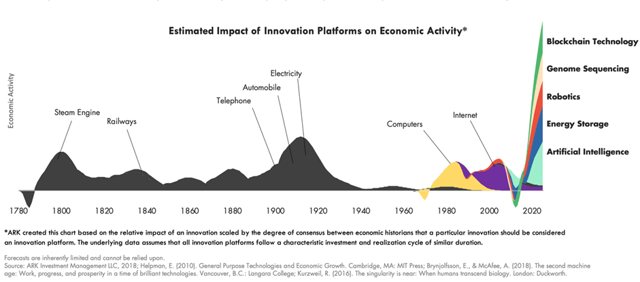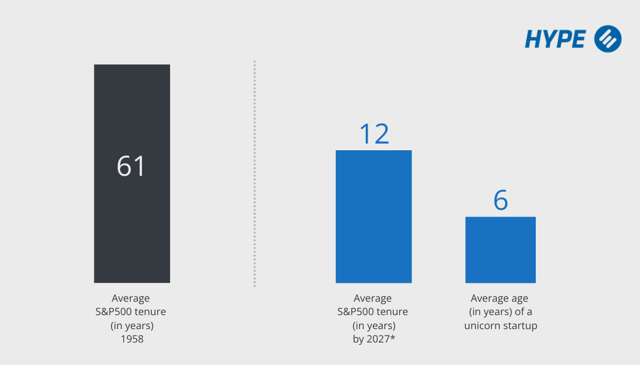Unless you’ve been living under a rock, you’ve probably heard a thing or two about AI in the last year. The launch of ChatGPT has supercharged the hype around AI, and now we’re seeing dramatic progress at a pace unlike anything that’s come before.
For those of us into innovation, it’s an exciting time.
Much has been said about the topic at large so I won’t go over the details here. At HYPE, what we’re most excited about is what AI can do for innovation management. We’ve already spent some years looking into AI’s role in the future of innovation management.
Here, I share HYPE’s current thinking and answer some key questions:
- What can AI do for innovation management?
- What are some common use cases?
- How can you operationalize AI’s use in innovation management?
The Current State of Innovation Management
Before we answer those questions, let’s review how most organizations carry out innovation management.
We’re all familiar with the innovation funnel.

To oversimplify, you gather ideas, review them, and then select the best ones to move forward to the pilot stage and eventual implementation. After each phase, poor ideas get weeded out.
It’s systematic, it’s conceptually simple, and investment is tiered so that you don’t spend too much time or money before an idea has shown its potential. What’s not to love?
Well, there are a few key challenges: the process is slow, linear, and is usually biased due to the evaluation criteria selected for the gates or decision points (if you use a Phase-Gate model).
Each of these challenges can be mitigated with smart adaptations of the process, but the funnel has another fundamental limitation: It’s generally built for a world where innovation requires significant capital expenditures and vast amounts of proprietary information.
But, regardless of your industry, that just isn’t the case anymore. Now most information is freely available, and technology has come a long way, in many cases because of AI. For example, pharmaceutical companies use AI to accelerate drug discovery while infrastructure and manufacturing companies use advanced simulation techniques, digital twins (virtual replicas of physical objects or systems), and rapid prototyping.
It’s now possible to innovate, test, and validate ideas faster than ever with minimal investment. With the right guidance, these tasks don't have to be limited to innovation experts like you anymore. That can be an intimidating thought, but it’s also an empowering one. Soon, thanks to AI, you’ll be able to scale your expertise and make an impact significantly bigger than before.
For more than 20 years, we’ve been helping our customers succeed in this era of systematic innovation management. Today, countless organizations manage trends at scale, collect insights and ideas from a wide and diverse audience, and then manage that funnel highly effectively.
Yet, despite, or maybe because of this, more and more seemingly well-run organizations are struggling to keep up and adapt to the future.
What gives?
The Future of Innovation Management
Some say that innovation is decelerating. Research reveals that as technology gets more complex, coming up with the next big scientific breakthrough is likely to require more and more investment, which makes intuitive sense. We see this type of research as really about invention. The economic impact of these inventions has always come in waves, as highlighted in ARK Investment’s research, illustrated below. Throughout history, significant inventions have created platforms that enable dramatic progress through their practical application or, in other words, through innovation. ARK firmly believes that we’re on the precipice of another such wave and one that is likely to be bigger than any that has come before. AI is probably the most important of these platforms, but it’s not the only one.

Whether that will be the case remains to be seen, but regardless, the economic impact of innovation typically derives from the creative combination of existing “building blocks,” be they technologies, processes, or experiences.

Famously, the more such building blocks or types of innovation you combine to solve a specific pain point or challenge holistically, the more successful you’re likely to be. Thanks to more and more information and technology becoming free or highly affordable worldwide, change has accelerated rapidly in most industries.
That’s why, despite the evident deceleration of scientific progress in many industries, companies have to fight harder to stay relevant and change dramatically more quickly, as evidenced by the average tenure of S&P500 companies dropping like a stone.
In most industries, sustainable competitive advantages are a thing of the past. Now, it’s all about strategically planning for, as well as adapting to, change. This is what’s known as transient advantage, and it’s already a reality for most organizations.
How Innovation Management Needs to Change
In this landscape, the traditional innovation funnel isn’t cutting it anymore. Organizations can’t just focus on research and then turn that into new products and expect to do well.
To be clear, that doesn’t mean that the funnel will no longer work, just that managing it well is no longer enough. It’s table stakes. Innovating better than the next company is getting harder and more expensive.
When we look at our most successful customers and the most successful companies in the world in general, they have several things in common:
- They have significantly faster cycle times than the competition at every step of the innovation process, i.e., they simply move faster.
- For them, innovation is not a team, department, or process. It’s an activity the entire organization undertakes.
- As such, they innovate everything, not just their products but also processes, experiences, business models, and more.
When you put these together, the pace of innovation leaves the competition in the dust.
How can you maximize the pace of innovation at your organization? In a nutshell, it comes down to having:
- A well-structured and streamlined process for different kinds of innovation;
- Appropriate tools, techniques, capabilities, and structures to support these processes;
- A strategy and culture that values innovation;
- A network of partners to accelerate learning and progress.
With these components in place, you’ll empower most people in the organization to deliver innovation, not just come up with ideas, and that makes all the difference in the world.

What Role Does AI Play in Innovation Management?
In the last couple of years, we’ve seen massive advancements not just in the quality of AI models and tools, but especially in the affordability and ease of their application. What used to be feasible for just a handful of the biggest and wealthiest companies out there is now quickly commoditizing. Generative AI, which has attracted most of the buzz, is merely the tip of the iceberg.
In just a few years, AI is likely to play a transformative role in the products and services most organizations provide.
For innovation managers too, AI will have dramatic and widely applicable benefits by speeding up and improving the way you work and innovate.
Let’s dive a bit deeper.
AI as an Accelerator
At HYPE, because we believe that using AI as a tool is something every organization that wants to innovate needs to do, we’ve been focusing on applying it to innovation management for some time. For example, we’ve identified and built a plethora of use cases where AI can be helpful, and it’s not just about generative AI. Other types of models and approaches still have their place as well.
There are too many use cases to cover here in detail, but we generally view AI’s use as falling into three buckets:
- Augmenting: AI can augment human creativity, uncover new perspectives, kickstart work, help alleviate some of the inevitable biases, and make top-notch coaching available for everyone.
- Assisting: AI-powered tools can assist innovators in research and ideation, summarize large amounts of information quickly, provide feedback, and help find, analyze, and make the most of vast quantities of structured or unstructured information.
- Automating: AI can automate both routine and challenging work, to improve the speed and efficiency at which you can operate and save time so that you can focus on the value-added tasks at the heart of innovation.
In a nutshell, with the right AI tools, you can move faster, make smarter decisions, and operate more efficiently across virtually every part of the innovation management process.
While effective on their own, it’s only by putting the “three As” together and operationalizing them across the organization that you can unlock the full power of AI and take your innovation work to the next level.
In a nutshell, with the right AI tools, you can move faster, make smarter decisions, and operate more efficiently across virtually every part of the innovation management process.
While effective on their own, it’s only by putting the “three As” together and operationalizing them across the organization that you can unlock the full power of AI and take your innovation work to the next level.
Putting AI Into Practice
So, what’s the key to success with AI?
At HYPE, we think the key is understanding that AI is not just one “big thing.” It’s a versatile and powerful enabling technology that has become considerably cheaper and will likely continue on the same trajectory.
There are significant opportunities for using AI to deliver more value for customers, but organizations need the right data and talent to maximize the opportunities and to enable AI to support how their business operates, not least in the field of innovation management. It’s essential to find the right ways to apply AI to specific business needs; just asking everybody to use ChatGPT won’t cut it.
.jpg?width=640&height=427&name=helena-lopes-2MBtXGq4Pfs-unsplash%20(1).jpg)
The anecdotal evidence we’re hearing highlights that learning to use a plethora of different AI tools and operationalizing these across an organization can often become challenging, time-consuming, and expensive.
To overcome these issues, there’s a real benefit in finding ways to operationalize AI as a part of the tools and processes you already use. And that’s where we believe The HYPE Suite with its built-in AI capabilities can make a big difference for our customers.
Final Thoughts
At the start of this article, we asked “Is AI the future of innovation management?”
In short, we think the answer is yes. But the question misses the real point.
Almost everyone is already using AI in at least some way, and over time, it will be everywhere. As an enabling technology, it’s a bit like computers or the Internet: Sure, you can innovate without them, but if everyone else uses them and you don’t, you’ll be slower and end up with a worse outcome.
The real question is how well you use and operationalize AI to support your innovation ambitions, whatever they may be. Using AI in combination with the right tools and processes, you can innovate better and faster than the competition.
At HYPE, we have many AI features in our development roadmap that will complement the software solutions we already have in place. Please reach out to us if you’d like to get an early sneak peek into what’s coming up!










